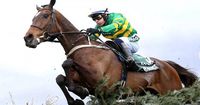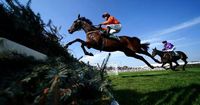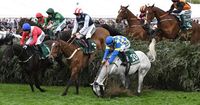The Grand National is once again upon us, drawing racegoers from across the country to Aintree for the biggest event on the steeplechase calendar. This year, the iconic race took place on Saturday, April 5, 2025, with millions tuning in to witness the spectacle. However, the event is no stranger to tragedy, as it has been marred by the loss of horses over the years.
On this opening day of the Grand National Festival, a somber note was struck when four-year-old Willy De Houelle suffered a fatal injury during the Juvenile Hurdle, making him the 66th horse to die at the Aintree Festival since 2000. Ridden by Rachel Blackmore and owned by Susannah Ricci, Willy De Houelle fell on the fourth hurdle out from the finishing line. Despite the best efforts of the medical team, the horse could not be saved, leaving many shaken, including Blackmore, who was assisted into an ambulance following the incident.
In total, 34 horses competed in this year’s Grand National, with 16 finishing the race. The race was won by Nick Rockett, who was ridden by Patrick Mullins and trained by his father, Willie Mullins. However, the aftermath of the race remains uncertain as Broadway Boy and Celebre D'Allen were both assessed on course after suffering falls during the event. As of now, it is unclear whether they sustained any fatal injuries.
The Grand National, which first took place in 1839, has seen a total of 88 horses lose their lives during the race. The British Horseracing Authority (BHA) has reported that the fatal injury rate in Jump racing is approximately 0.44% of runners. While the BHA has made strides in regulating the sport, the inherent risks of racing remain a concern.
In response to the ongoing safety concerns, significant changes have been implemented at Aintree in recent years. Ahead of the 2024 Grand National, The Jockey Club announced several measures aimed at reducing the number of falls and injuries. These included moving the start time from 5:15 PM to 4 PM, reducing the number of participants from 40 to 34, and shifting the first fence 60 yards closer to the start line to enable horses to approach at a slower speed. Additionally, the height of the 11th fence was lowered by two inches to 4 feet 10 inches.
Despite these changes, the Grand National continues to face scrutiny from animal rights activists. The event attracts a worldwide audience of approximately half a billion people, with an estimated 13 million adults in the UK placing bets. However, the dark side of this beloved race is its history of fatalities, with 18 of the 88 deaths occurring since 2000. The tragic deaths of horses at Aintree have prompted calls for further reforms and a reevaluation of the safety measures in place.
Last year, the race, won by I Am Maximus, saw no horses die in the main event, although two horses did perish during the three-day festival. Giovinco fell during the Mildmay Novice Chase, and Pikar broke its neck in the Aintree Handicap Hurdle. In 2023, the Grand National was marred by the deaths of four horses, including Hill Sixteen, Dark Raven, Envoye Special, and Hullnback, who died weeks after the festival due to complications.
Animal rights organizations have been vocal about their concerns, with the RSPCA urging the BHA to review the circumstances surrounding each death at Aintree. Campaigners from Animal Aid have called for jump racing to be banned altogether, citing the ongoing fatalities as unacceptable. The number of deaths in the main race has varied over the years, with 2024 marking a significant improvement as no horses lost their lives during the event.
The statistics reveal a troubling trend: since 2000, the number of deaths in the Grand National has fluctuated, with a peak of three in 2023 and two in 2022. The latest changes, introduced in 2012, aimed to enhance safety, yet the total number of deaths across all events since then remains high, with 61 horses having died in various races.
The Grand National remains a thrilling spectacle, but the balance between excitement and safety continues to be a contentious issue. As this year’s race unfolds, the focus will undoubtedly remain on the well-being of the horses and jockeys alike. The excitement of the race, coupled with the ongoing safety concerns, ensures that the Grand National will remain in the spotlight.
As the dust settles on the 2025 Grand National, the hope is that the changes implemented will lead to a safer environment for all participants. The legacy of the Grand National is one of tradition, but it must also evolve to prioritize the welfare of the horses that make this event possible.
In conclusion, the Grand National is a celebration of equestrian excellence, but it is also a reminder of the risks involved in the sport. With ongoing efforts to improve safety and welfare, there is hope for a future where such tragedies become a thing of the past.







